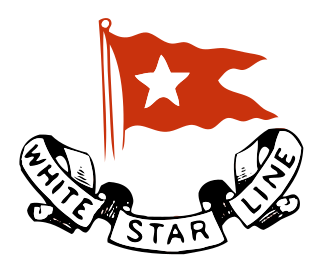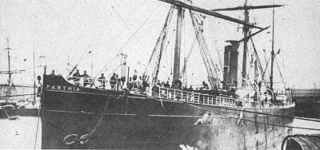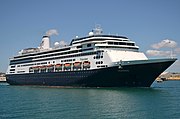
The White Star Line was a British shipping line. Founded out of the remains of a defunct packet company, it gradually rose up to become one of the most prominent shipping companies in the world, providing passenger and cargo services between the British Empire and the United States. While many other shipping lines focused primarily on speed, White Star branded their services by focusing more on providing comfortable passages for both upper class travellers and immigrants.

SS Oceanic was the White Star Line's first liner and first member of the Oceanic-class; she was an important turning point in passenger liner design. Entering service in 1871 for Atlantic crossings, she was later chartered to Occidental and Oriental Steamship Company (O&O) in 1875. The ship provided passenger service for O&O in the Pacific until 1895 when she was sold for scrap.

USS Ariel (AF-22) was the United Fruit Company cargo and passenger liner Peten, renamed Jamaica in 1937, that served as a United States Navy Mizar-class stores ship in World War II.

The Pacific Mail Steamship Company was founded April 18, 1848, as a joint stock company under the laws of the State of New York by a group of New York City merchants. Incorporators included William H. Aspinwall, Edwin Bartlett, Henry Chauncey, Mr. Alsop, G.G. Howland and S.S. Howland.

MV Georgic was the last ship built for the White Star Line before its merger with the Cunard Line. Built at Harland and Wolff shipyard in Belfast, she was the running mate of MV Britannic. Like Britannic, Georgic was a motorship, and not a steamer, fitted with a diesel powerplant. At the time of her launch in 1931, she was the largest British motorship.

SS Arabic, originally built as Berlin, was a passenger steamship launched on 7 November 1908 which was built by the AG Weser shipbuilding company in Germany. Her gross register tonnage was advertised at 16,786 tons. She made her maiden voyage on 1 May 1909 from New York to Genoa and Bremerhaven. In September 1914 she became an auxiliary cruiser with the Imperial German Navy as a minelayer.

SS Cymric was a steamship of the White Star Line built by Harland and Wolff in Belfast and launched on 12 October 1897.

SS Doric was a British ocean liner operated by White Star Line. She was put into service in 1883. Built by the Harland and Wolff shipyards in Belfast, she was the sister ship of the Ionic which was put into service a few months earlier. Although the original purpose of the construction of the two ships was not known with certainty, both began their careers chartered by the New Zealand Shipping Company which operated them on the route from London to Wellington.

Comet was an 1851 California clipper built by William H. Webb which sailed in the Australia trade and the tea trade. This extreme clipper was very fast. She had record passages on two different routes: New York City to San Francisco, and Liverpool to Hong Kong, and beat the famous clipper Flying Dutchman in an 1853 race around the Horn to San Francisco.

SS Belgic was a steamship of the White Star Line. The first of the company's four ships bearing this name, she was first assigned, with her sister ship, the Gaelic on the route to France and South America, where the company has recently tried to establish itself. The experience was short-lived, however, and at the end of the year, the Belgic was the last White Star Line steamer to serve on this route. She was then moved to the North Atlantic route.

SS Coptic was a steamship built in 1881, which was successively owned by the Oceanic Steam Navigation Company, the Pacific Mail Steamship Company, and the Japanese Oriental Steam Ship Co. before being scrapped in 1926. She was filmed by Thomas Edison in 1897 in one of his early movies. The movie is currently stored in the Library of Congress.

SS Gaelic was a steamship of the White Star Line, built by shipbuilders Harland and Wolff of Belfast.

SS Parthia (1870–1956) was an iron-hulled transatlantic ocean liner built for the Cunard Line by William Denny and Brothers in Dumbarton, Scotland. Her sister ships were the Abyssinia and Algeria. Unlike her two sisters, Parthia was smaller, built in a different shipyard and had a slightly different funnel arrangement. The Parthia was retired by Cunard in 1883 and sold to John Elder & Co., who subsequently transferred her to the Guion Line. After serving with the Guion Line and operating on trans-Pacific routes with the Canadian Pacific Railway Company, she was refitted and renamed Victoria.

The Occidental and Oriental Steamship Company was an American shipping company founded in 1874 by US railroads wishing to provide competition to the Pacific Mail Steamship Company which had not complied with its obligations to them. Chartering vessels from different companies, the most important being the British White Star Line, the company quickly became financially successful, against the expectations of its founders.

The SS Belgic was a steam ship built by Harland and Wolff for the White Star Line for service in the Far East and across the Pacific. Sold to the Atlantic Transport Line in 1899 she was transferred to the North Atlantic. After service as a Boer War transport she was scrapped in 1903.

The Oceanic class were a group of six ocean liners built by Harland and Wolff at Belfast, for the White Star Line, for the transatlantic service. They were the company's first generation of steamships to serve the North Atlantic passenger trade, entering service between 1871 and 1872.

Wolverine State was a steam passenger-cargo ship built in 1919–1920 by New York Shipbuilding Company of Camden for the United States Shipping Board (USSB) as part of the wartime shipbuilding program of the Emergency Fleet Corporation (EFC) to restore the nation's Merchant Marine. The ship was initially employed on the United States to India route until its cancellation in Spring 1922. After remodeling the vessel was briefly used by the Los Angeles Steamship Company on a run between Los Angeles and Honolulu as an emergency replacement for one of their burned out steamers. In April 1922 the steamer was renamed President Harrison. In 1923 she conducted several trips between California and the east coast of South America, before being sold together with several other ships of her class to the Dollar Steamship Company. The vessel was captured in 1941 by the Japanese after she was deliberately run aground to avoid the capture. After repairs, the ship was renamed Kachidoki Maru (勝鬨丸), put under control of NYK Line and entered the Japan to Taiwan route, but soon after was requisitioned by the Imperial Japanese Army. Under IJA control the ship sailed between Japan, Singapore and the Philippines carrying troops and military supplies. She was torpedoed and sunk on 12 September 1944 on one of her regular trips, while carrying 950 Allied prisoners of war of which 431 were killed.

West Cajoot was a Design 1013 cargo ship built in 1919 by the Los Angeles Shipbuilding & Dry Dock Co of Los Angeles. She was one of many ships built by the company for the United States Shipping Board.

USS Radnor (ID-3023) was a cargo ship and later troop transport that served with the United States Navy in 1918–19, during and shortly after World War I. The ship later went into merchant service, and in 1948 under Chinese ownership reportedly became the first all-Chinese ship to visit South America. Radnor was originally ordered as SS War Indian by a private company, but with U.S. entry into World War I in April 1917, she was requisitioned by the U.S. Navy for use as a cargo ship. Commissioned as USS Radnor (ID-3023) in May 1918, the ship spent the remainder of the war transporting cargoes for the Navy. After the war, USS Radnor was converted into a troop transport and used to repatriate U.S. troops home from France.

The SS American was a steamship built by Harland and Wolff in Belfast, which entered service in 1895. the American was a combined cargo and passenger ship which was originally built for the West India and Pacific Steamship Company along with her sister ship the SS European. In 1904 she passed to the White Star Line and was renamed Cufic, the name she retained until she was sold to Italian ownership in 1924, after which she became known as Antartico then Maria Guilia until being scrapped in 1932.





















